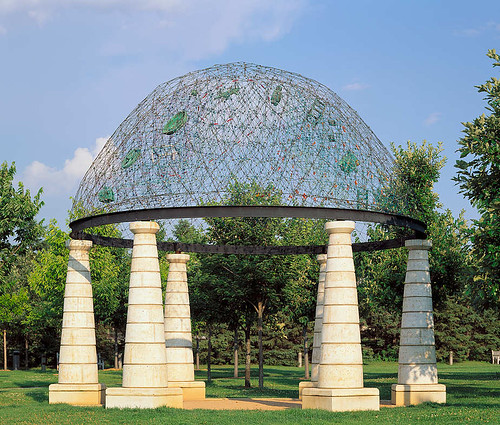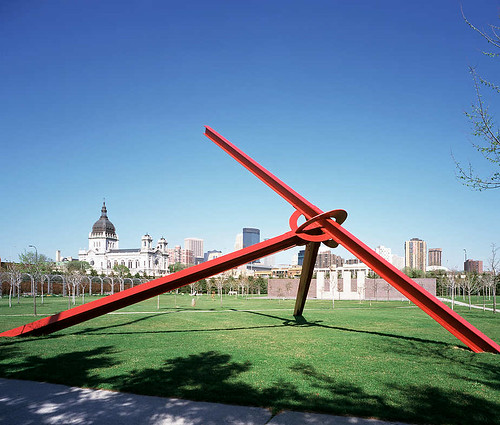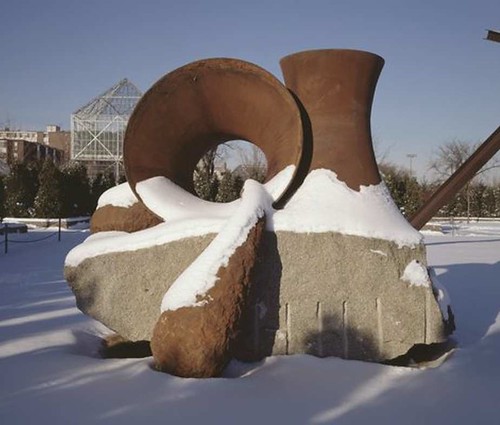Gold Medal Park to Host Walker Sculptures
 Sunday, February 15, 2015 at 4:51PM |
Sunday, February 15, 2015 at 4:51PM |  David Tinjum |
David Tinjum | WALKER ART CENTER ANNOUNCES PLAN TO RELOCATE SCULPTURES DURING MINNEAPOLIS SCULPTURE GARDEN RECONSTRUCTION
NEW PARTNERSHIPS WITH WEISMAN ART MUSEUM, MINNEAPOLIS INSTITUTE OF ARTS, AND GOLD MEDAL PARK ALLOW FIVE SCULPTURES TO REMAIN ACCESSIBLE TO THE PUBLIC
The Walker Art Center announced a number of sculptures from the institution’s collection on view in the Minneapolis Sculpture Garden will temporarily relocate to the Weisman Art Museum, the Minneapolis Institute of Arts, and Gold Medal Park this summer and remain on view during the Minneapolis Sculpture Garden Reconstruction Project.
Nearly all Garden artworks will be placed in storage during construction, but thanks to innovative partnerships with the Gold Medal Park Conservancy Fund, the MIA, and the Weisman, several of the most beloved sculptures will relocate through short- or long-term loans, and remain accessible to the public. The loans
are renewable each year and the partnering organizations have agreed to the arrangement for up to 5 years, after which time the loans will be reevaluated.
Brower Hatcher’s Prophecy of the Ancients(1988), Mark di Suvero’s Molecule (1977-83), and Tony Cragg’s Ordovician Pore (1989) will be loaned short-term to Gold Medal Park, which sits adjacent to and reunites with the Guthrie Theater, the Garden’s former neighbor.
COMING TO GOLD MEDAL PARK
Prophecy of the Ancients by Brower Hatcher
Brower Hatcher was trained in engineering and industrial design before he turned to sculpture in the early 1970s. In his stone and steel-mesh sculpture for the Garden, he melds the logic of an engineer with a visionary’s impulse to transcend time and space. A futuristic dome, composed of thousands of flexible wire polyhedrons, rests atop six mock-Egyptian columns in a blend of ancient and modern architectural styles. Embedded within the structure and seeming to hover in space are an assortment of common objects and abstract forms: a table, a ladder, a chair, a turtle (whose patterned shell recalls the gridded structure of the dome), random letters, numbers, discs, and dashes. Hatcher offers up these private symbols for universal interpretation, as viewers are inspired to construct their own meanings from the galaxy of images suspended above them.
Molecule by Mark di Suveros
The monumental scale and sweeping gestures of this red-painted sculpture are characteristic of the enormous outdoor structures Mark di Suvero has been making since the 1970s, using cranes to manipulate the massive industrial materials with which he works. Here, a pair of enormous steel beams meet at their ends, creating a triangular form that tips at an alarmingly improbable angle. At the point of the beams’ juncture are sections of two flat, centerless discs. A longer beam forms the final leg of the tripod, but travels on some 38 feet into the air, piercing a third disc interwoven with the other two at the point of intersection. The cumulative effect recalls all the visual and emotive force we attach to the atomic world: dynamic, red-hot, powerful, and strangely elegant. Molecule, like all of di Suvero’s large-scale sculptures, invites the viewer to inspect its lines and spaces from every angle.
Ordovician Pore by Tony Cragg
Trained as a scientist, Tony Cragg creates art that investigates the natural world. Yet if his sculptures comment on such topics as molecular structure, the human vascular system, or the Newtonian light spectrum, it is his use of man-made forms (either found or constructed) that transforms them into complex meditations on contemporary life. Here Cragg has constructed steel elements on a granite base—two smooth-surfaced concave cylindrical forms and two elemental biomorphic shapes—that comment on the Ordovician geological era of 500 million years ago, when oxygen was introduced into the atmosphere. While the oxygen gave rise to terrestrial life, it simultaneously killed off the species of algae that had produced it. The close resemblance of the cylinders to the cooling towers of nuclear power plants perhaps suggests an analogous life-death conundrum for our own technological age.




Reader Comments